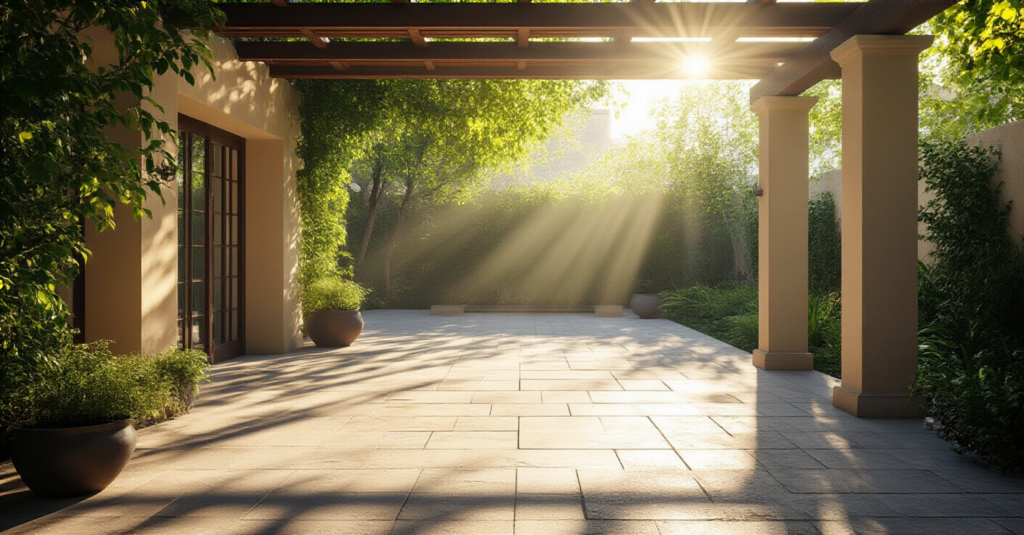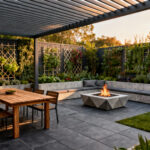I have a confession. For years, I thought creating a beautiful patio was about having a “green thumb”—some kind of magical ability to make things grow. I watched clients struggle, thinking they were the problem when their plants died. But I was wrong. A thriving patio isn’t about magic. It’s about thoughtful design. It’s about creating a space that adapts to your life, not the other way around.
The truth is, good patio design is universal design. It means planning for changes, making things easier, and creating a space that brings you joy whether you’re chasing toddlers, using a walker, or simply too busy to fuss over needy plants. It’s not about finding the trendiest plants; it’s about understanding the handful of things that actually matter. The rest is just noise. I learned this the hard way, by watching beautiful, expensive plants wither in spaces that weren’t designed for life. So let’s talk about how to get it right from the start.
Intelligent Planning for a Thriving Patio Oasis (Part 1)
This is the part everyone wants to skip, and it’s the single most important part. Planning isn’t about making a rigid, complicated blueprint. It’s about having a quiet conversation with your space before you spend a dime. It’s where you set the foundation for a patio that feels like a sanctuary, not a chore list.
1. Evaluate Your Patio’s Daily Sunlight Exposure Zones
You know what people always ask me? “What’s a good plant for a sunny patio?” My answer is always the same: “Tell me about your sun.” Not all sun is created equal. The intense, baking sun of 4 PM is a world away from the gentle morning light at 9 AM. Believing your patio is “full sun” all day is the number one mistake that leads to fried, miserable plants.
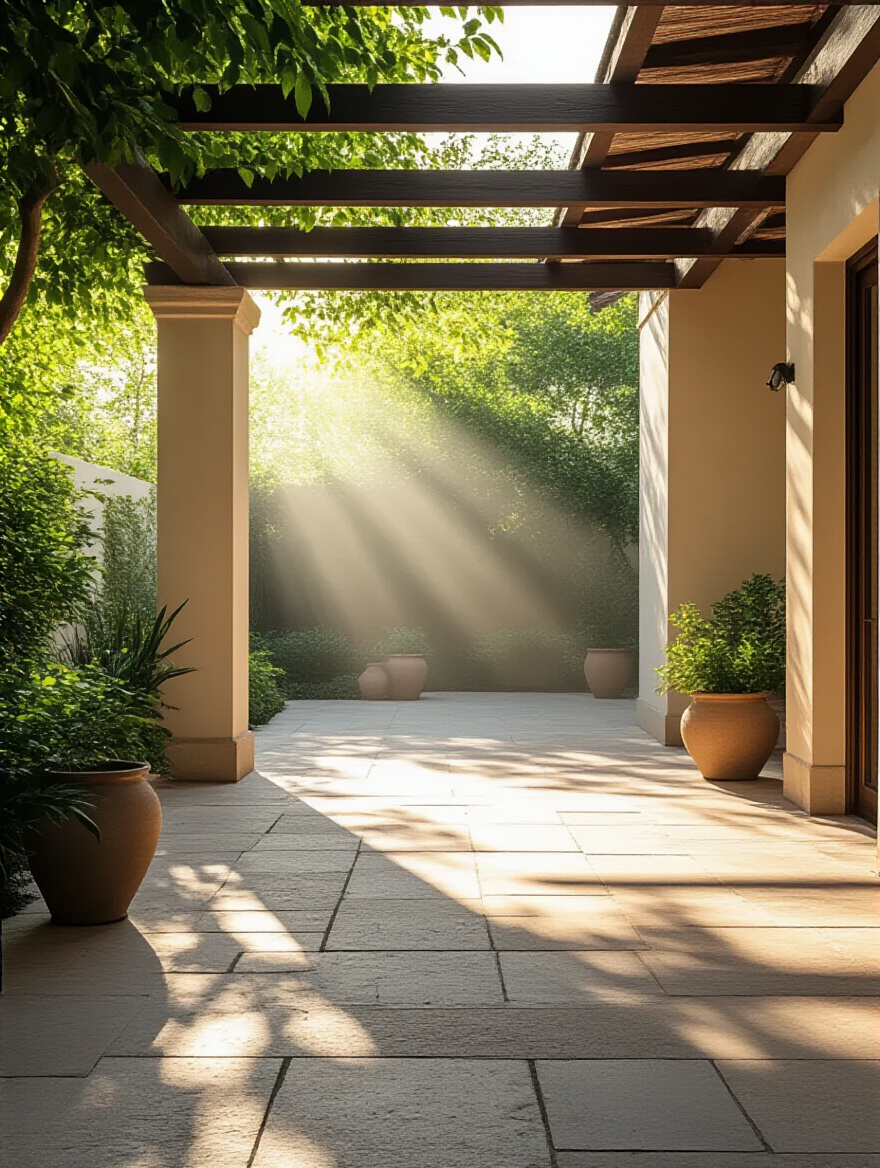
The only way to know for sure is to be a detective for a day. Grab your phone, and take a picture of your patio every hour, from morning until evening. You’ll quickly see the reality. That corner you thought was sunny? It’s probably in shade by 2 PM. That spot by the door? It gets blasted with heat reflected off the glass. This simple one-day audit is the secret map to success. It tells you exactly where a sun-worshipping lavender will thrive and where a delicate fern won’t be scorched to a crisp.
Once you have this light map, the rest becomes incredibly simple. You’re no longer guessing; you’re placing plants where they are destined to be happy. This one act of observation will save you more money and heartbreak than any other tip on this list.
2. Determine Available Space and Weight Capacity for Containers
Okay, let’s talk about something that isn’t glamorous but is critically important: weight. Especially if your “patio” is a balcony, a deck, or a rooftop. I once visited a client who had installed these enormous, gorgeous ceramic planters along the edge of their beautiful wooden deck. What they didn’t realize was that a big pot filled with wet soil and a growing tree can weigh hundreds of pounds. They were putting their deck—and their safety—at risk.
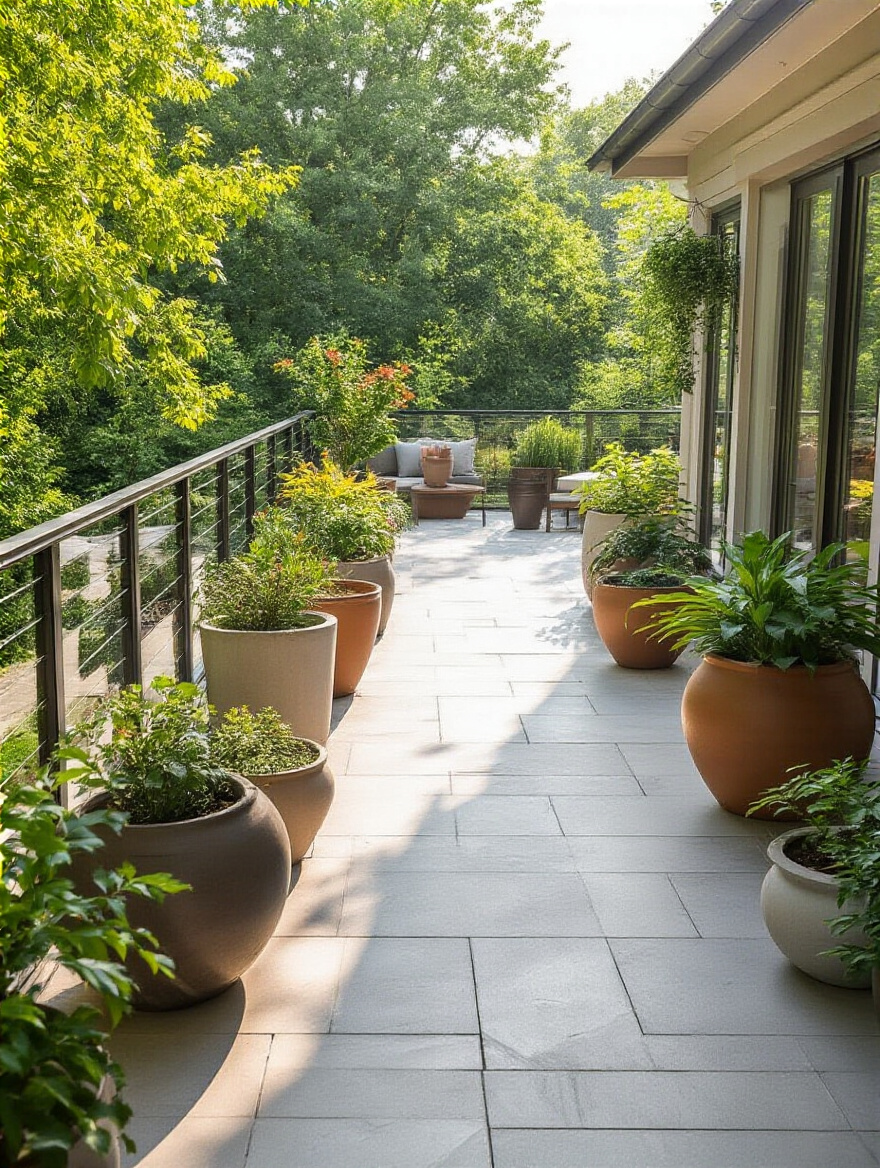
Before you go shopping, know your limits. Measure your space not just for footprint, but for flow. You need clear, wide pathways for people, for a wheelchair, for a child on a tricycle. A universally designed space is a safe space. Then, think about weight. If you’re on a balcony or deck, find out its load capacity. Opt for lightweight fiberglass or resin pots instead of heavy ceramic or concrete. You can get the same beautiful look without the structural stress. This isn’t about limiting your dream; it’s about making your dream smart and sustainable.
Thinking about space and weight from the start frees you up to be more creative. It pushes you to think vertically, to choose materials wisely, and to build a garden that is both beautiful and fundamentally safe for everyone who enjoys it.
3. Assess Local Climate and Hardiness Zone for Plant Resilience
You wouldn’t wear a winter coat in the desert, right? So why do we so often ask our plants to do the same? Every region has a USDA Hardiness Zone, which is just a fancy way of saying “this is how cold it gets here in winter.” Knowing your zone is your first filter for choosing plants that actually have a chance of surviving year after year. A plant labeled “perennial” is only perennial if it can handle your winters.
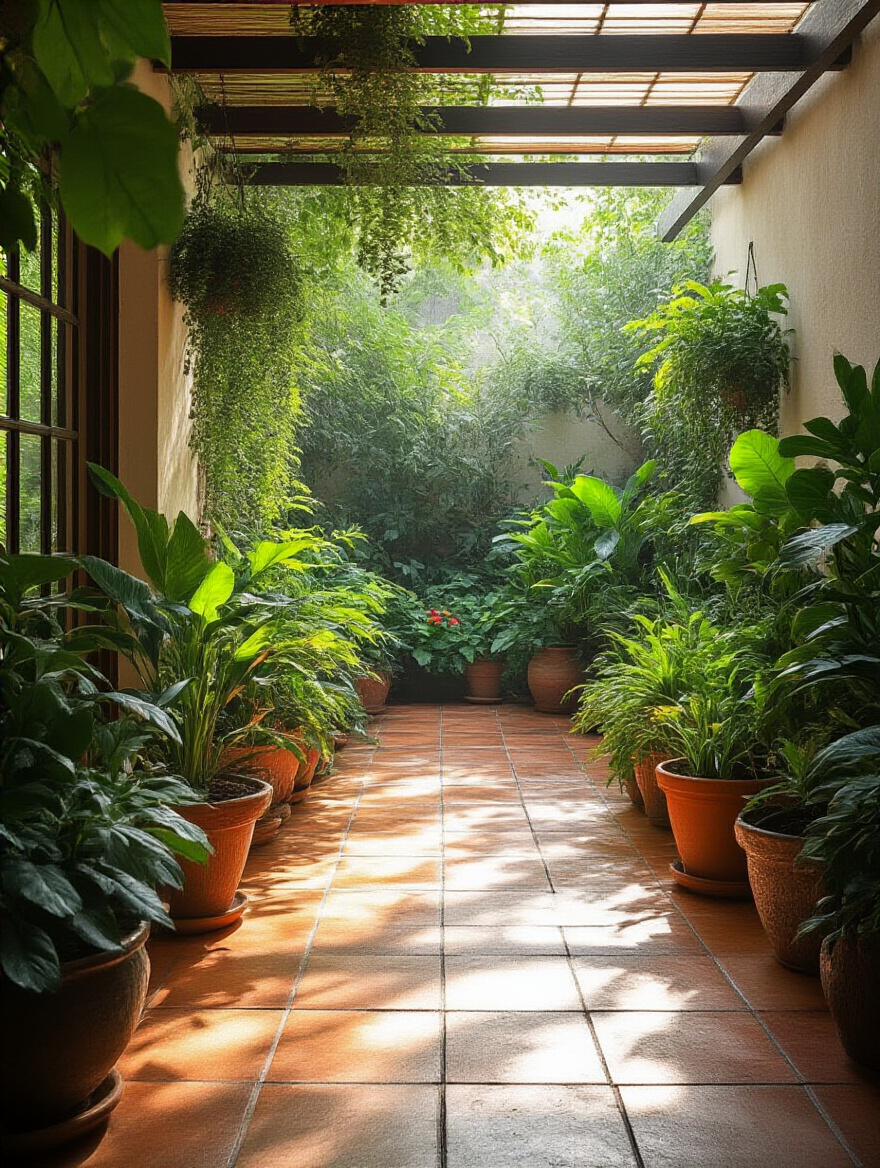
But don’t stop there. Your patio is its own little world—a microclimate. A brick wall that soaks up afternoon sun can create a pocket of heat that’s a full zone warmer than the rest of your yard. A windy corner on the third floor can feel a zone colder. Pay attention to these little details. They are the clues that tell you why a plant might struggle in one spot but thrive just ten feet away.
This isn’t about memorizing scientific charts. It’s about acknowledging reality. Choosing plants that are naturally suited to your climate means less work, less water, and more success. It’s the ultimate shortcut to a garden that feels effortless.
4. Define Desired Aesthetic and Functional Goals for Your Green Space
Picture this: you’re standing on your empty patio. What do you want to do here? Before you think about a single plant, think about the life you want to live in this space. Is this where you’ll have your morning coffee in peaceful solitude? Is it a lively hub for family dinners? A safe play area for your kids? A quiet spot for an elderly parent to enjoy the fresh air?
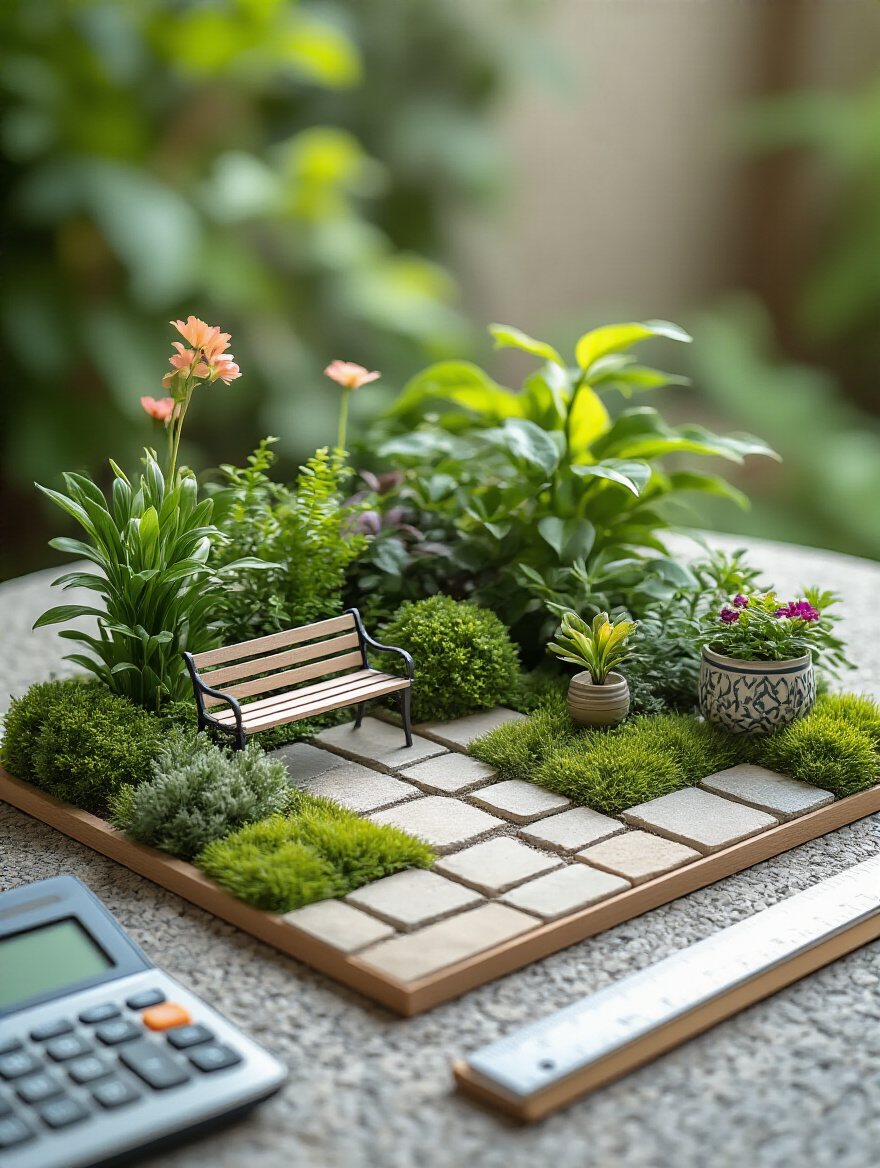
Your answer to that question is the foundation of your design. A space for quiet reflection might call for soft, calming foliage and fragrant herbs. A vibrant entertaining hub could feature bold, colorful flowers and durable, movable planters. If you want to grow food, you’ll need to prioritize your sunniest spots for vegetables and herbs in raised beds that are easy to reach. Function always comes first. When you design for the life you want, the aesthetic will follow naturally.
This is the heart of my design philosophy: a space should serve people, not the other way around. When your patio is designed with purpose, every plant, every pot, and every chair has a reason for being there, creating a place that feels not just beautiful, but deeply and truly yours.
Intelligent Planning for Thriving Patio Oasis (Part 2)
We’ve mapped our sun and defined our purpose. Now we get our hands dirty—figuratively, for now. This is about creating the perfect foundation for our plants to live in, because a healthy home is the secret to a happy plant.
5. Select Potting Mix Formulations Specific to Plant Needs
Can we talk about why everyone gets soil wrong? They walk into a store, grab the cheapest bag labeled “Potting Soil,” and then wonder why their succulents rot and their ferns dry out. Here’s the truth: using a generic potting mix is like feeding a professional athlete and a quiet librarian the exact same meal. It just doesn’t work.
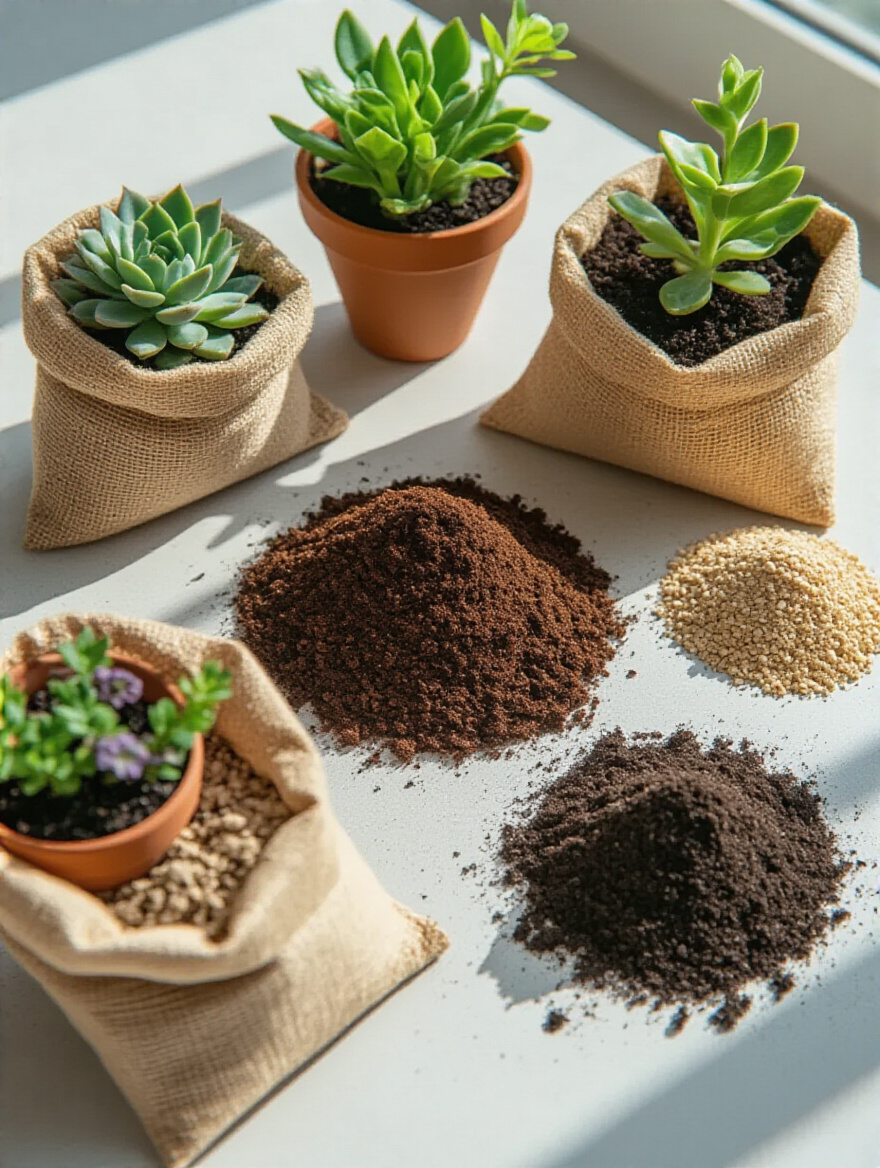
Think of potting mix as a plant’s habitat. Cacti and succulents need a gritty, sandy mix that drains instantly, mimicking their desert home. Tropical ferns and flowers need a rich, spongy mix with peat or coir that holds onto moisture. Using the right mix is the difference between a plant that merely survives and one that absolutely thrives. Don’t cheap out here. Investing in the correct, specialized mix for your plant type is the best money you will spend.
This simple choice prevents the two biggest killers of container plants: root rot (from soil that’s too wet) and dehydration (from soil that can’t hold water). It is, without a doubt, the easiest shortcut to looking like you have a green thumb.
Smart Plant & Container Choices for Lasting Beauty (Part 1)
Now for the fun part: choosing our green cohabitants and their homes. But we’re going to do it smartly, choosing plants and pots that will make our lives easier and our patios more beautiful for years to come, anticipating changes and celebrating resilience.
6. Prioritize Drought-Tolerant Plants for Low-Maintenance Enjoyment
I have seen the joy that a simple pot of flowers can bring to an older client, and I’ve also seen their frustration when they can’t keep up with a demanding watering schedule. This is why I am such a huge advocate for drought-tolerant plants. They are the heroes of the low-maintenance, universally designed patio. These are plants—like succulents, lavender, ornamental grasses, and sedum—that have evolved to handle dry spells.
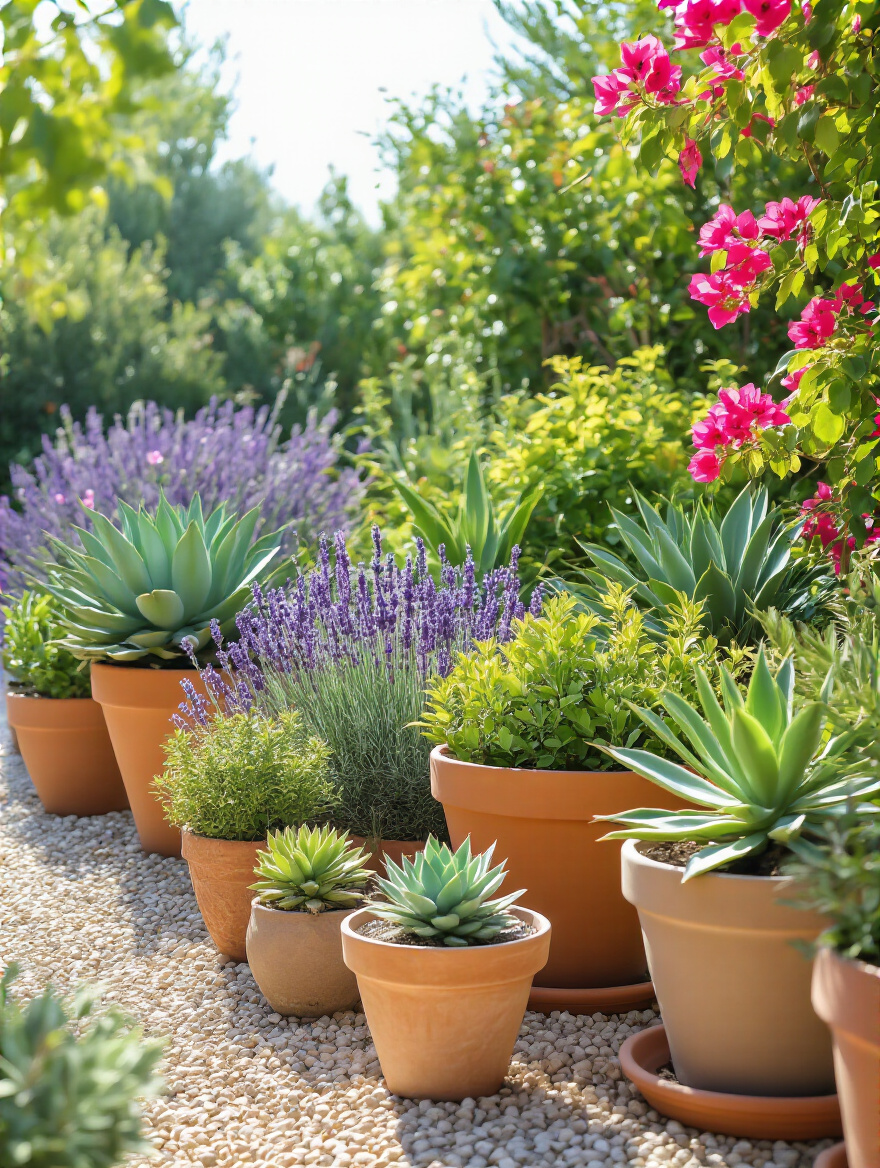
Choosing these plants isn’t about being lazy; it’s about being strategic. It means your patio will still look gorgeous even if you forget to water for a few days, or if you’re going through a season of life where you have less time or energy. It’s a way to build resilience directly into your garden. They offer incredible texture, structure, and beauty with a fraction of the work, giving you all the reward with none of the stress.
A patio filled with these workhorses frees you from the tyranny of the daily watering can. It creates a space of relaxation and beauty, not one of obligation and worry, and that’s a gift that everyone, at any age or ability, can appreciate.
7. Identify Shade-Loving Species for North-Facing or Covered Patios
That shady spot on your patio isn’t a problem; it’s an opportunity. So many people try to force sun-loving plants to grow in the shade and then blame themselves when they fail. Stop fighting your space and start working with it. There is an entire world of stunning plants that crave the cool, gentle light of a north-facing or covered patio.
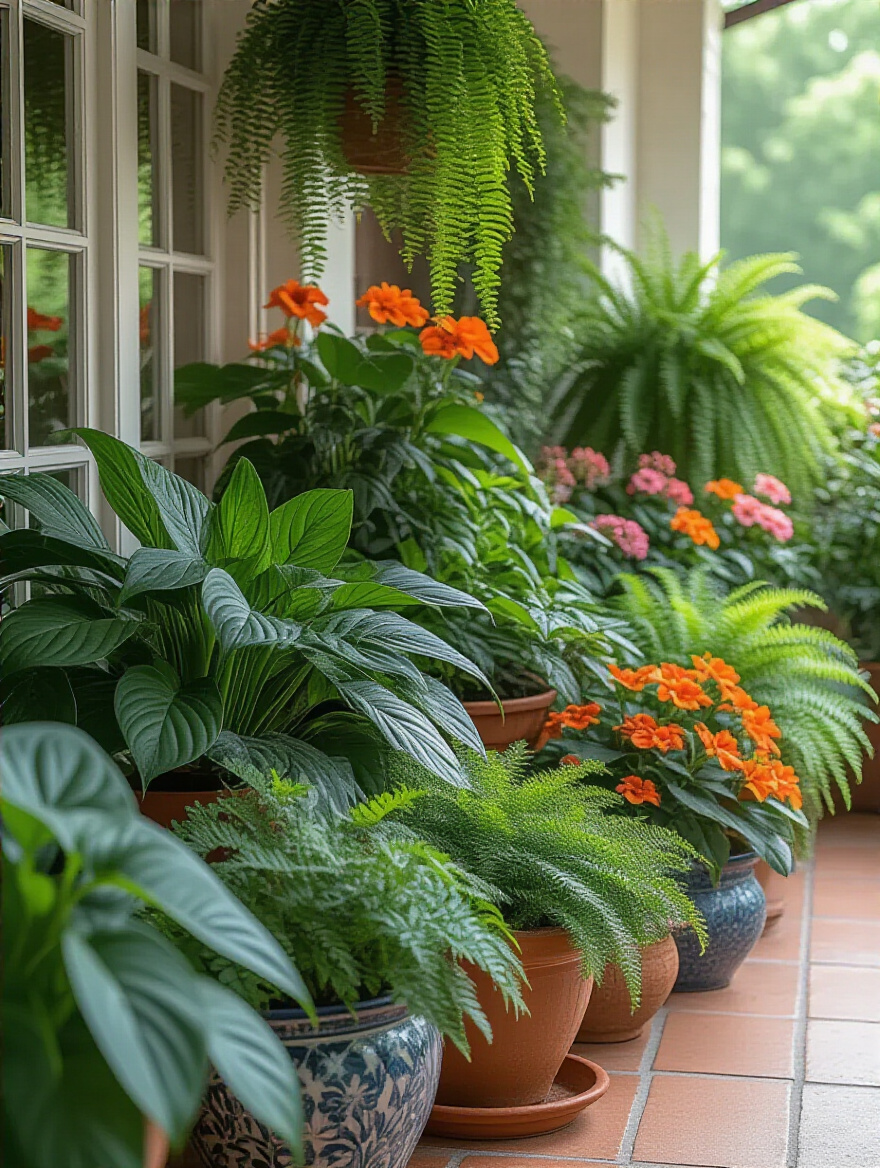
Think in terms of texture and leaf color. Hostas offer huge, architectural leaves in every shade of green, blue, and chartreuse. Ferns provide delicate, feathery texture. Heucheras (Coral Bells) come in astonishing shades of deep purple, amber, and lime. These plants don’t need loud flowers to make an impact; their beauty is in their form and foliage, creating a serene, lush, and elegant atmosphere.
A shade garden invites a different kind of appreciation. It’s a place of quiet beauty, a cool retreat on a hot day. Embracing your shade means you can create a vibrant oasis where other gardens would fail, turning a challenge into your patio’s greatest asset.
8. Incorporate Edible Herbs and Vegetables for Culinary Delight
There is something fundamentally joyful about stepping onto your patio to snip a few sprigs of basil for your pasta or a handful of mint for your tea. Growing edibles is one of the most rewarding ways to use your space. It connects you to your food, delights your senses, and brings an incredible amount of function to your garden. And you don’t need a huge yard to do it.
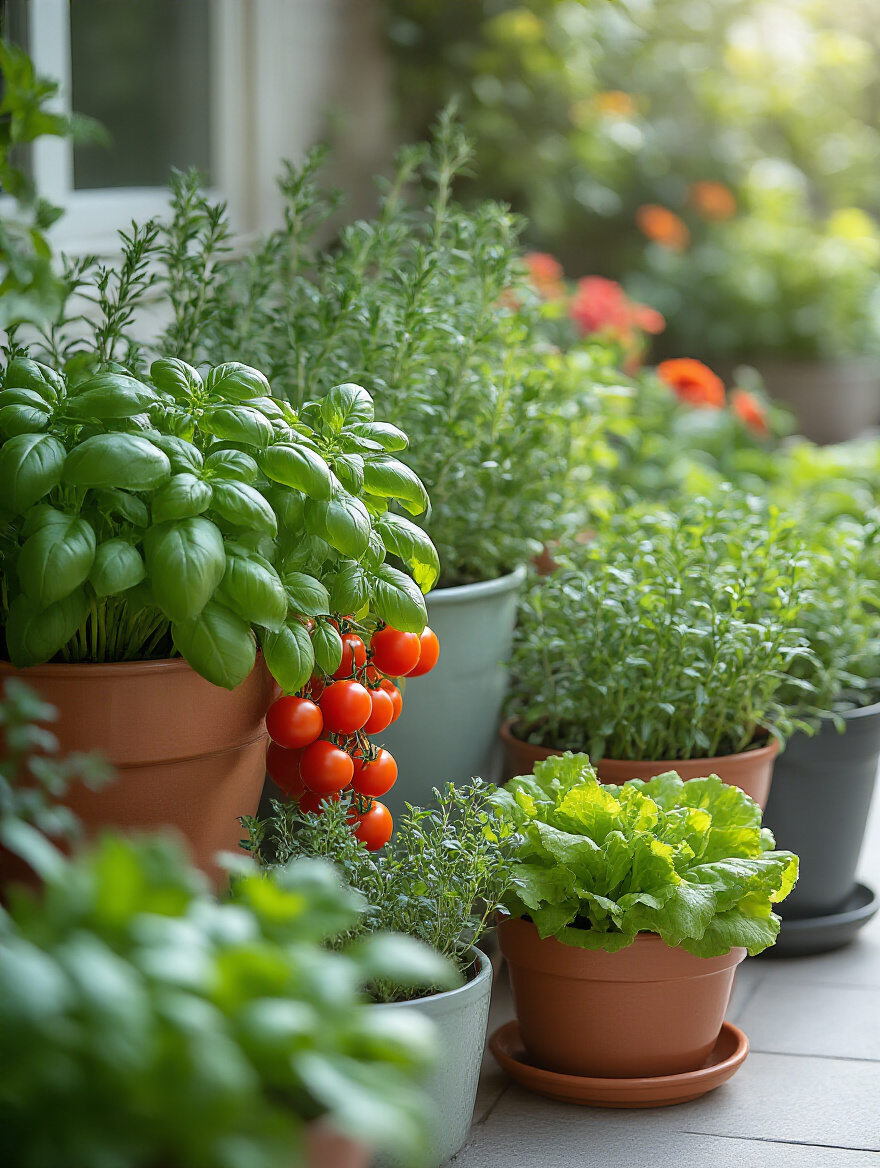
Many herbs and compact vegetable varieties are perfectly happy in containers. A sunny spot is all you need for a pot of rosemary, a window box of lettuce, or a hanging basket overflowing with cherry tomatoes. For anyone with limited mobility, a raised planter or a vertical wall garden can bring the joy of harvesting right to their fingertips without any bending or kneeling. It’s a perfect example of design that makes life better and easier.
The aroma of herbs warming in the sun, the convenience of fresh ingredients, the taste of something you grew yourself—these are the small, powerful moments that turn a patio from just a space into a central part of your home and life.
9. Choose Containers with Ample Drainage Holes to Prevent Root Rot
If I could shout one piece of advice from the rooftops, it would be this: DRAINAGE IS EVERYTHING. It is the one thing you absolutely cannot compromise on. The most common lie in the gardening world is that putting a layer of gravel at the bottom of a pot without holes will “create drainage.” It doesn’t. It does the exact opposite, creating a swamp in the bottom of your pot where your plant’s roots will drown and rot.
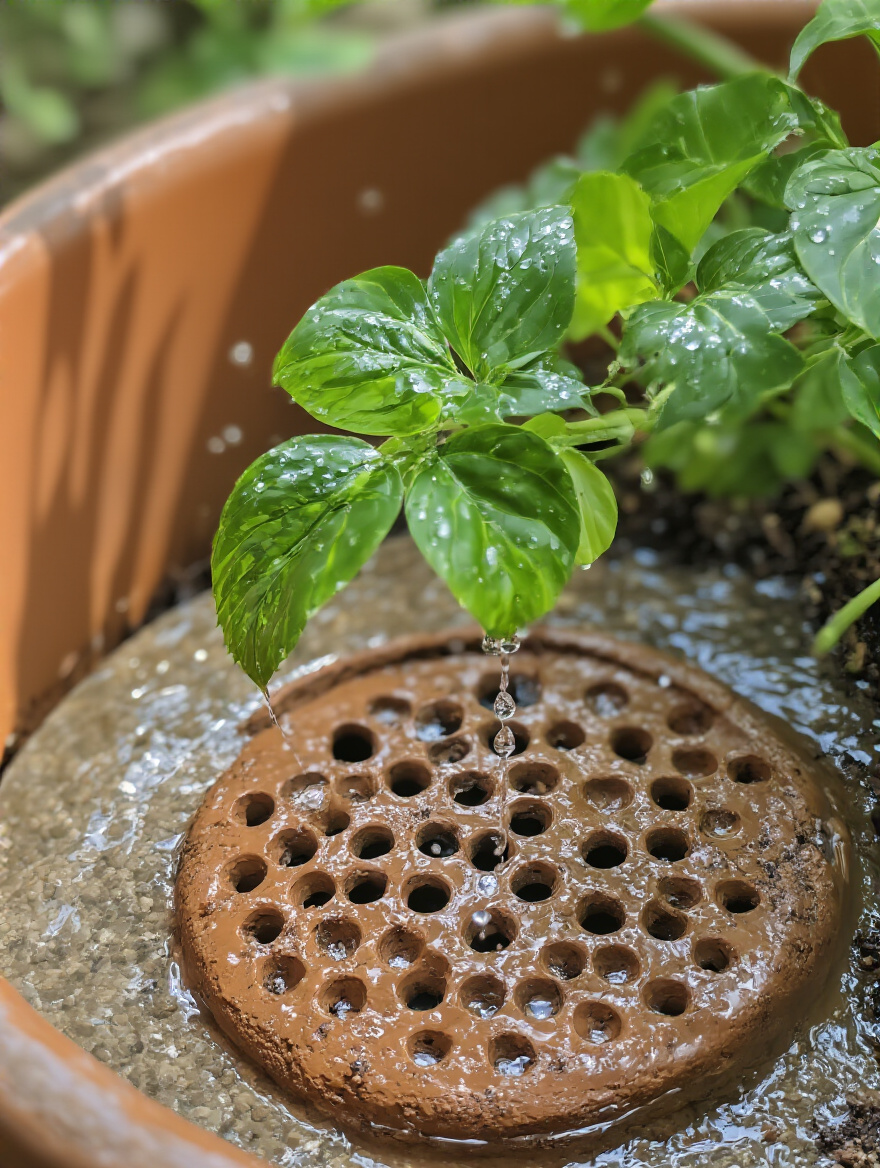
Every single pot you own must have holes in the bottom. No exceptions. If you fall in love with a beautiful decorative pot that doesn’t have a hole, you have two choices: drill one yourself (it’s easier than you think!) or use it as a “cachepot”—a decorative outer pot that you slip a plain plastic nursery pot (with holes!) inside of. This allows you to remove the inner pot for watering and let it drain completely before putting it back.
This non-negotiable rule is the secret to preventing the number one killer of container plants. Healthy roots need to breathe, and proper drainage ensures they get the oxygen they need while letting excess water—and the diseases it brings—escape.
Smart Plant & Container Choices for Lasting Beauty (Part 2)
We’re continuing our exploration of the physical elements that make up your patio garden. Getting these right means your plants have a stable, healthy home that looks great and functions perfectly within your overall design.
10. Select Appropriate Potting Material for Durability and Style
The material your pot is made of does more than just look pretty. It has a real impact on your plant’s health and on how much work you have to do. Classic terracotta is beautiful and porous, which means it breathes. That’s great for plants that hate wet feet, like succulents, but it also means the soil dries out very quickly in the sun, so you’ll be watering more often.
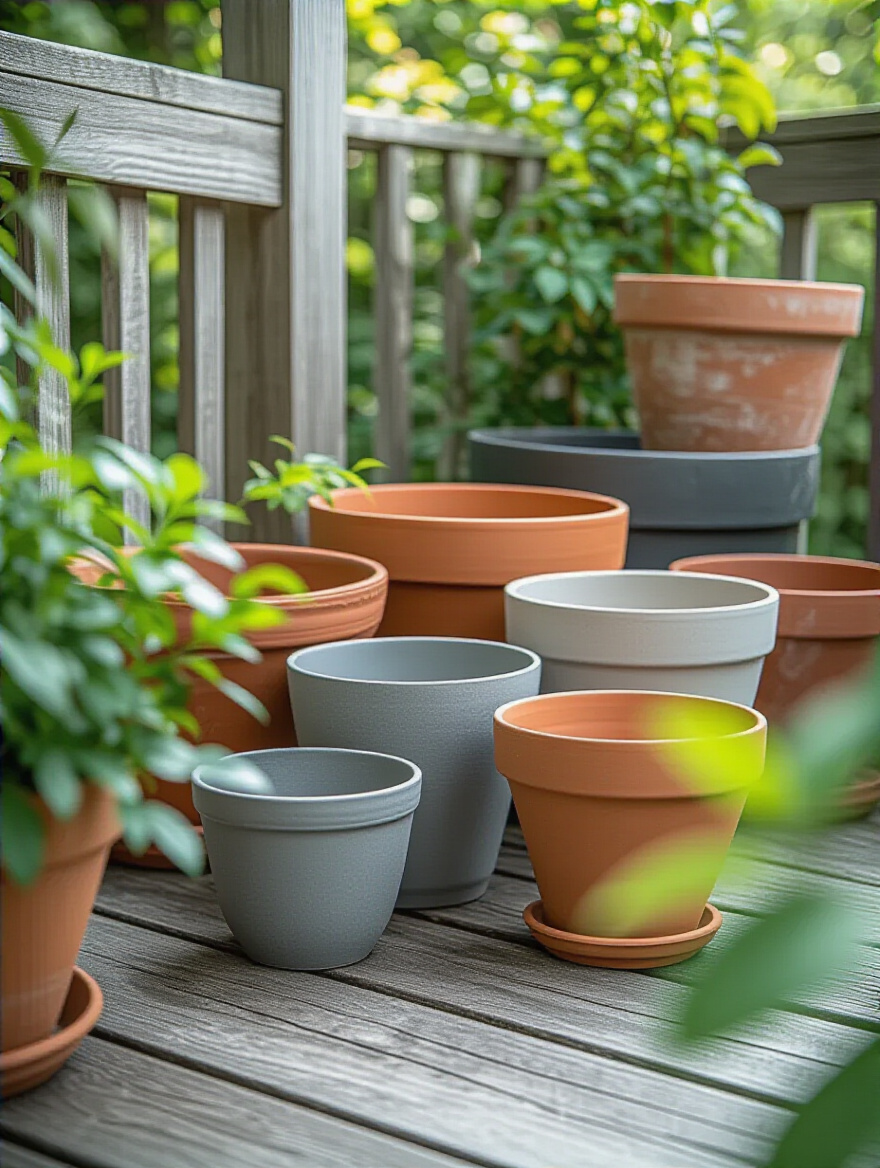
Glazed ceramic, plastic, and fiberglass pots aren’t porous, so they hold moisture much longer. This makes them a fantastic choice for thirsty plants or for anyone who wants to water less frequently. I particularly love lightweight fiberglass pots because they give you the look of heavy stone or ceramic without the back-breaking weight, making them easy to move and rearrange—a key feature of an adaptable, universally designed space. Choose the material that best suits your plant, your climate, and your lifestyle.
Thinking about material is another strategic shortcut. By matching the pot’s properties to the plant’s needs, you create a more forgiving environment, one that builds a bigger buffer for error and ultimately demands less of your time and energy.
11. Implement Proper Potting Techniques for Robust Plant Establishment
How you put a plant in its pot matters just as much as the pot itself. Think of it as welcoming a guest into a new home. You want to make them comfortable so they can settle in and thrive. Start by adding your specialized potting mix to the new pot, creating a small mound in the center.
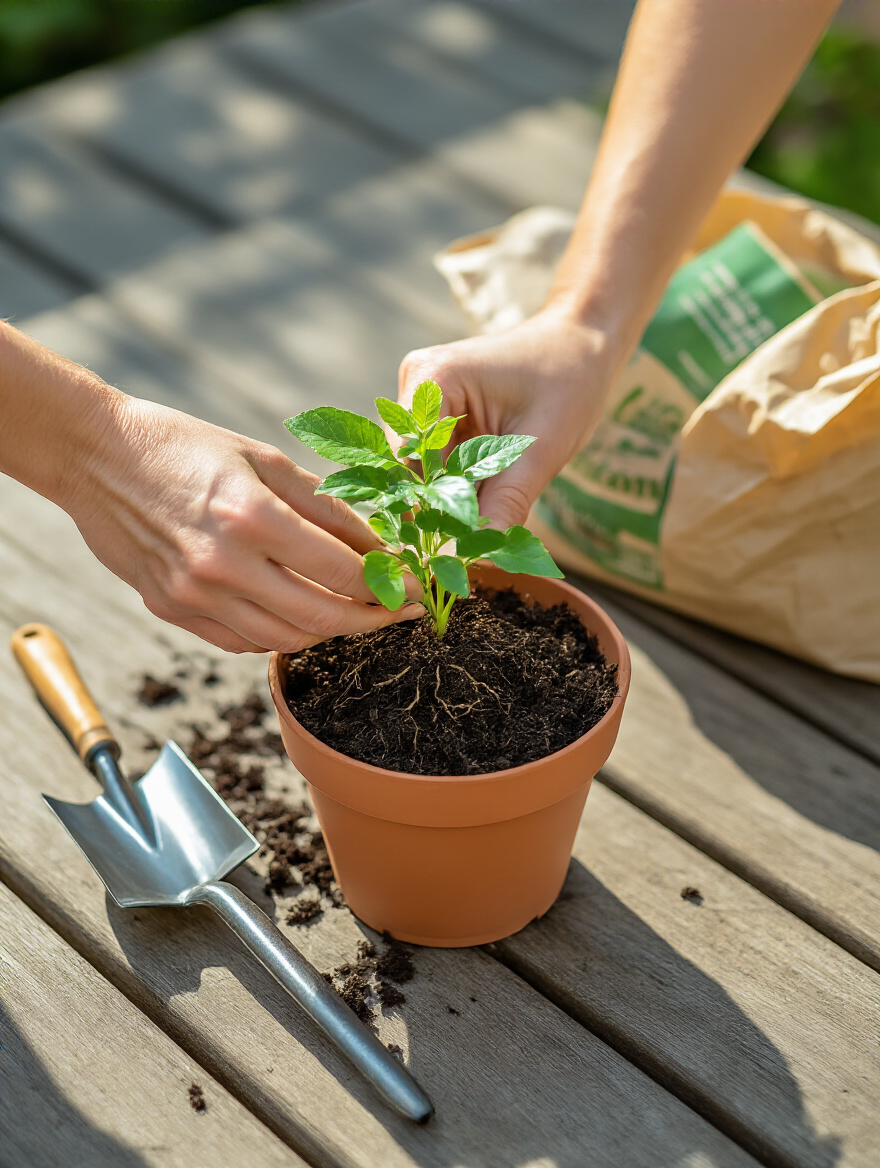
When you take your plant out of its original nursery pot, take a look at the roots. If they are circling tightly around the bottom, forming a dense mat, the plant is “root-bound.” You need to gently break that cycle. Tease the bottom roots apart with your fingers or even use a small knife to make a few vertical cuts in the root ball. This feels harsh, but it’s crucial. It tells the roots that it’s time to grow outwards into their new, spacious home instead of continuing to choke themselves. Set the plant on your mound of soil so the top of the root ball is about an inch below the rim of the pot, fill in around the sides, and water it well.
This simple act of “welcoming” your plant correctly sets it up for immediate success. It prevents transplant shock and encourages the plant to establish a strong, healthy root system from day one, which is the foundation for everything that happens above the soil.
Elevating Your Patio with Strategic Styling (Part 1)
With our foundation set and our plants happily potted, we can now turn to the artistry. Styling is about arranging these elements in a way that creates a cohesive, intentional, and deeply inviting space. This is where we create the feeling.
12. Create Visual Interest Using Varied Plant Heights and Textures
A patio where every plant is the same height is like a conversation where everyone speaks in a monotone. It’s boring. The secret to a lush, dynamic-looking patio is creating layers of interest by varying heights and textures. It’s a design trick that instantly makes your space feel more professional and thoughtfully composed.
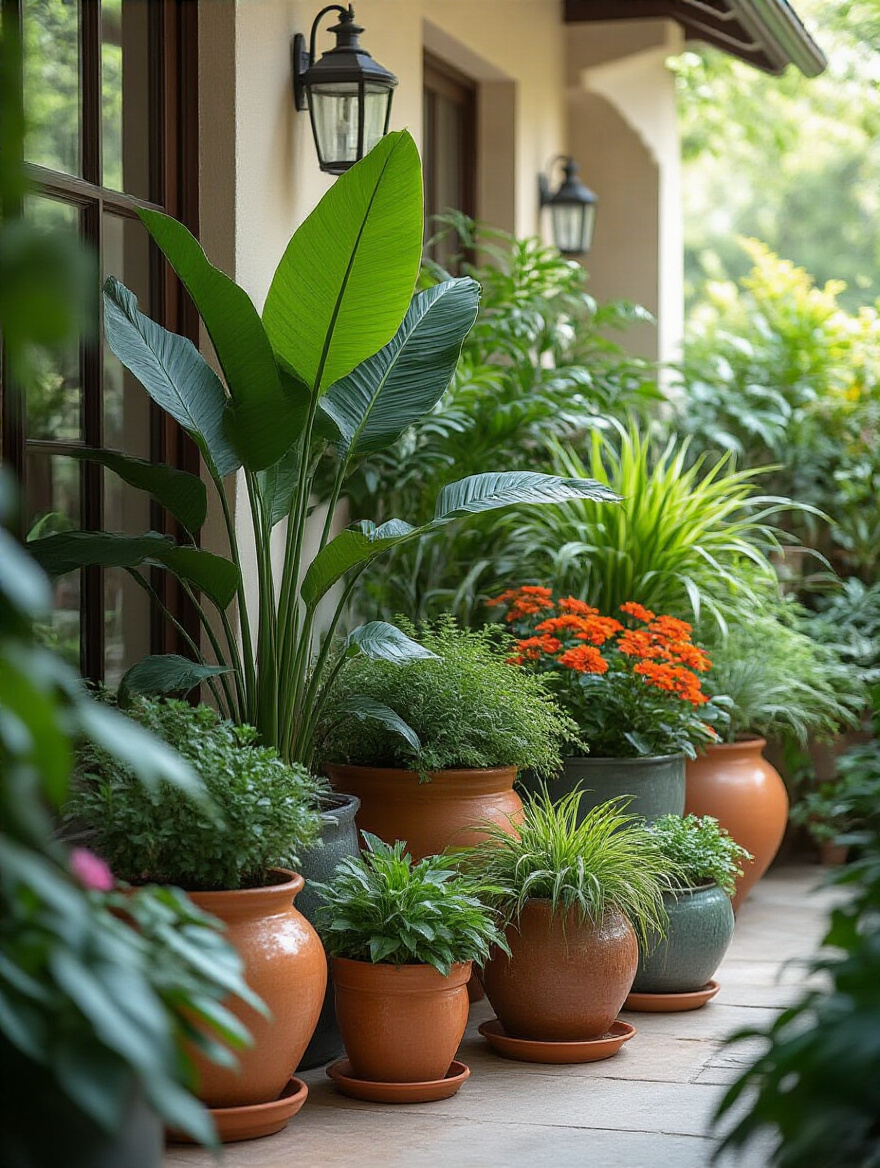
Think like a landscape designer and use the “Thriller, Filler, Spiller” concept. In a large container or a grouping of pots, your Thriller is a tall, dramatic, upright plant that provides a strong vertical element (like an ornamental grass). Your Filler is a more rounded, mounding plant that fills in the middle ground and adds mass (like a coleus or geranium). And your Spiller is a trailing plant that cascades over the edge of the pot, softening the lines and connecting it to the ground (like sweet potato vine or ivy).
This simple framework creates a beautiful, multi-dimensional arrangement that draws the eye and makes even a small collection of pots feel like a grand garden. It’s the difference between just having plants and having a design.
13. Design Cohesive Color Palettes with Blooming Annuals and Foliage
Resist the urge to buy one of every color at the garden center! A curated, intentional color palette is what separates a chaotic collection of plants from a sophisticated, harmonious design. Sticking to just a few colors will have a much bigger impact than a riot of disconnected shades.
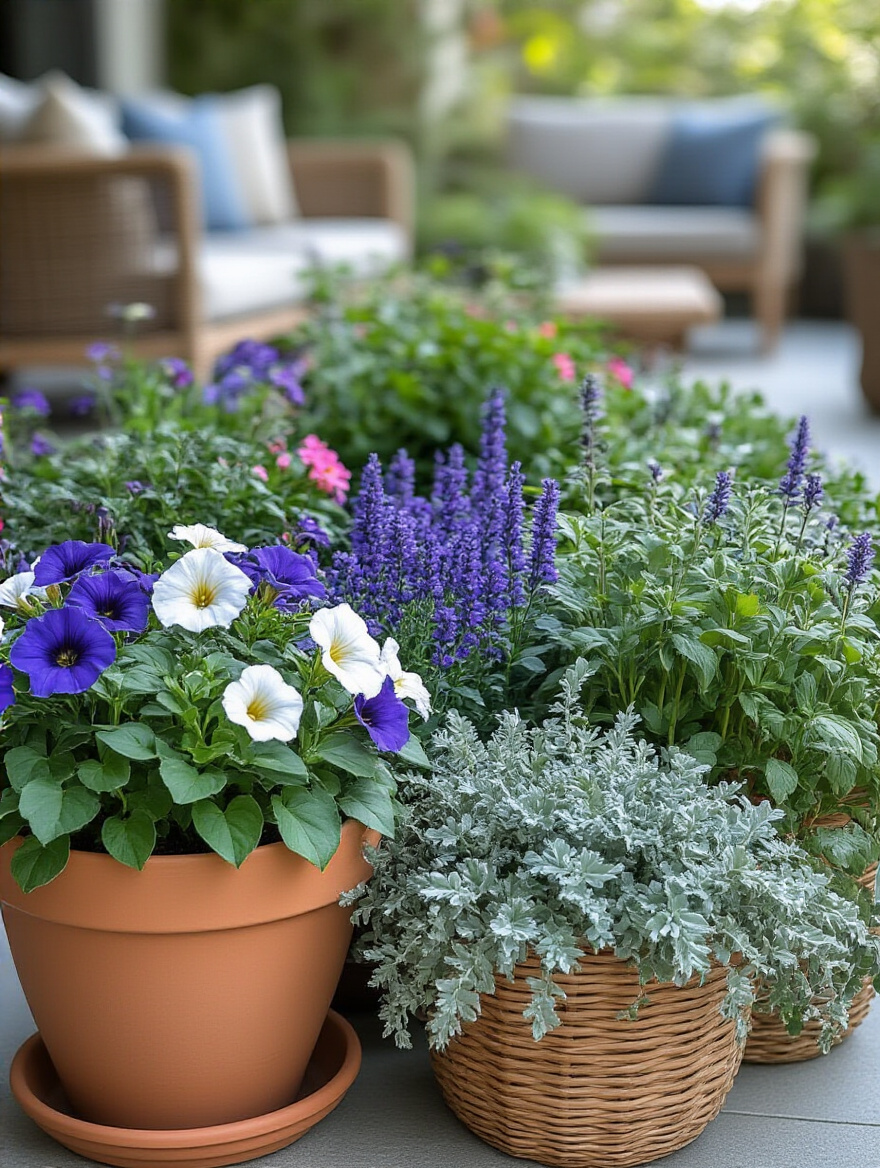
Choose a simple palette and repeat it throughout your space. Maybe it’s a serene combination of blues, purples, and silvery foliage. Or perhaps a fiery, energetic mix of reds, oranges, and yellows. The real pro move is to not forget the power of foliage. The deep burgundy, bright chartreuse, and speckled patterns of leaves can be just as colorful and impactful as any flower—and they last all season long.
A cohesive color story ties your whole patio together. It creates a sense of calm and order, allowing each plant to shine while contributing to a beautiful, unified whole. This deliberate choice makes your space feel restful and complete.
14. Maximize Vertical Space with Hanging Baskets and Trellises
Look up! One of the most underutilized areas on any patio is the vertical space. Using walls and overhead structures is a brilliant way to add lushness, create privacy, and make a small space feel so much bigger. A simple trellis against a bare wall can become a living work of art covered in a climbing clematis or jasmine. Hanging baskets add color and life at eye level, drawing the gaze upward.
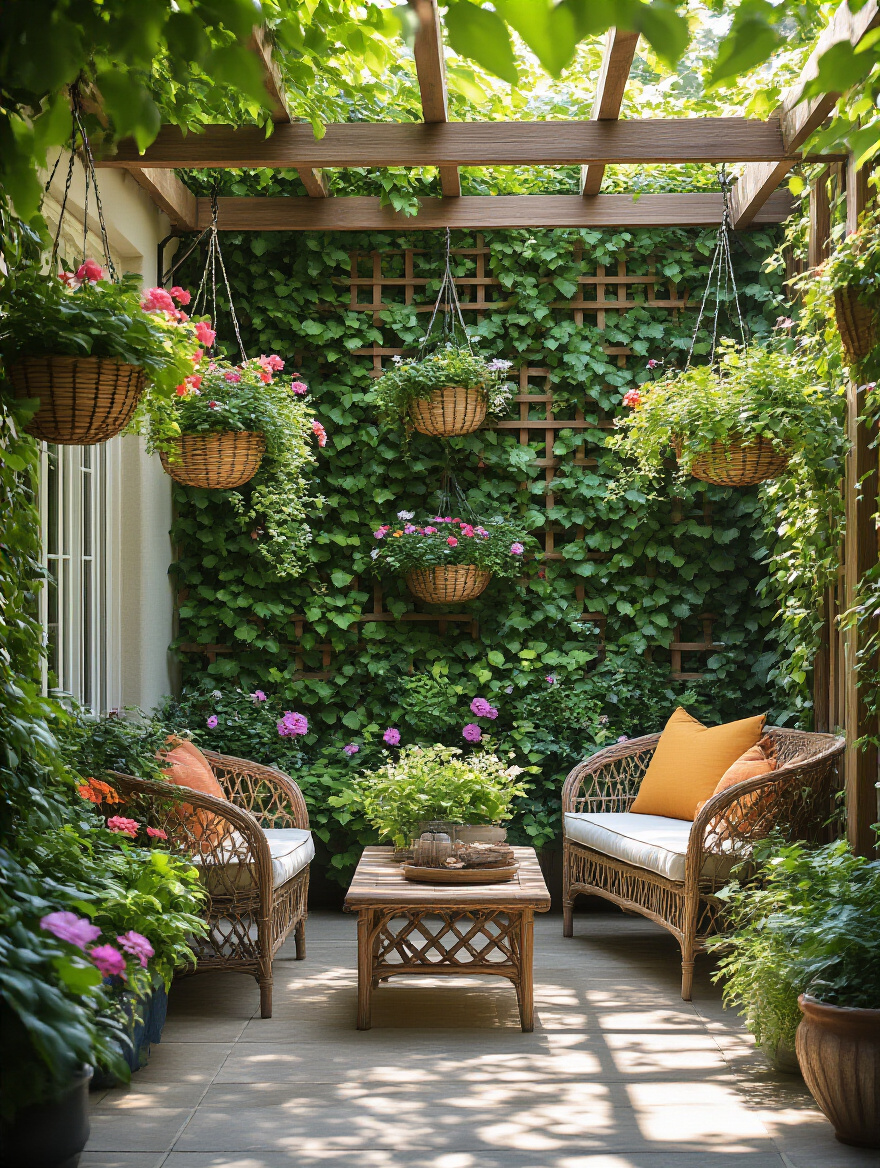
Vertical gardening is a cornerstone of accessible design. It allows you to have a full, vibrant garden without a single pot on the floor, keeping pathways clear and bringing the plants up to a level that can be enjoyed and cared for without bending or stooping. It’s an incredibly efficient and beautiful way to maximize every square inch you have.
By thinking in three dimensions, you unlock a whole new world of planting possibilities. You can create a green curtain for privacy, a wall of fragrant flowers, or a tower of fresh herbs, all while keeping your floor space open and functional.
15. Group Plants for Enhanced Microclimates and Aesthetic Impact
Don’t be afraid to cluster your pots together. Grouping individual containers into a larger arrangement does two wonderful things. First, it creates a much stronger visual statement. A collection of three or five pots of varying sizes feels intentional and lush, whereas a single pot can sometimes feel a bit lonely.
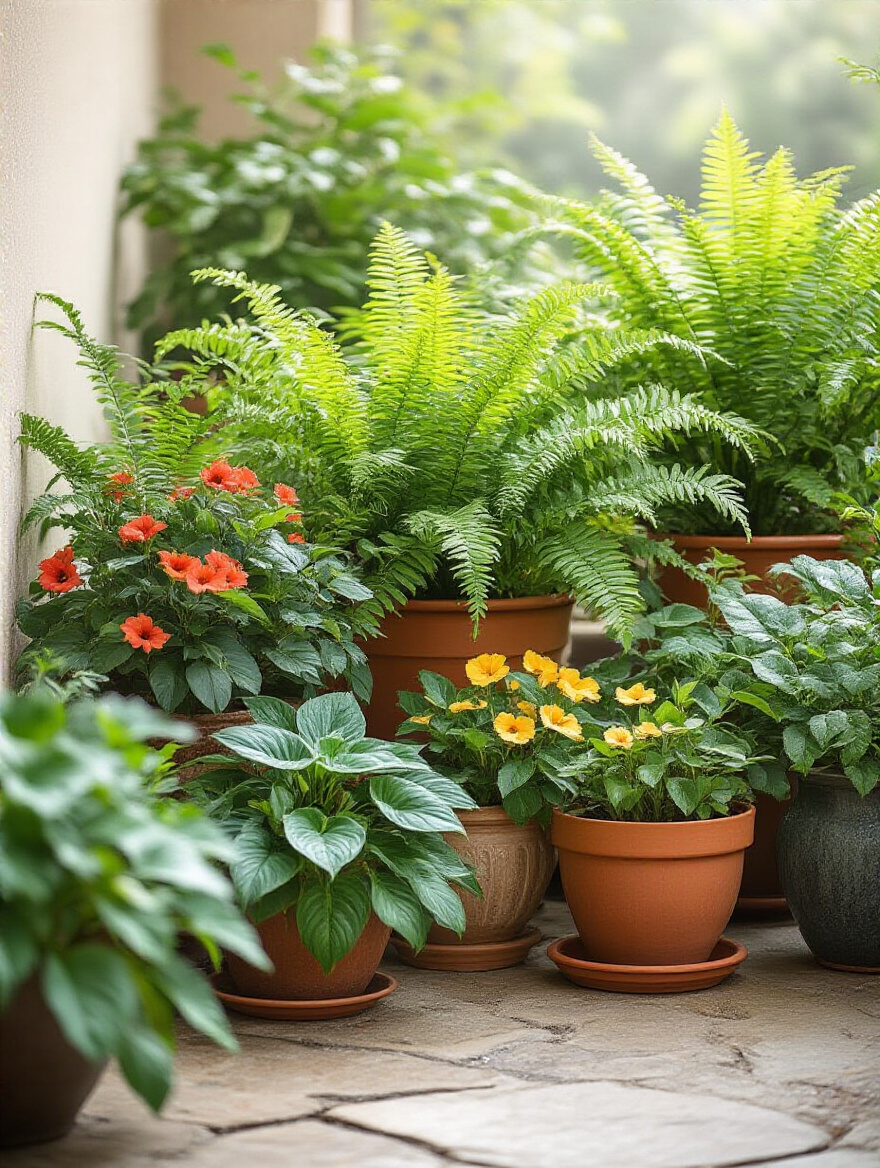
Second, and more importantly, grouping plants creates a beneficial microclimate. The plants shade each other’s soil, keeping the roots cooler. As they release moisture through their leaves (a process called transpiration), they raise the humidity in the air immediately around them. This little pocket of humidity is a gift to your plants, especially during hot, dry weather. They protect each other, making the entire group more resilient.
It’s a beautiful example of how community works, even in the plant world. By bringing them together, you create a system where each plant is healthier and the overall aesthetic is stronger. It’s an easy win that has a huge impact on both the health and beauty of your patio.
Elevating Your Patio with Strategic Styling (Part 2)
We’ve arranged our plants; now it’s time to add the finishing touches. These are the elements that weave your garden into the fabric of your home, making it a true outdoor room filled with personality and comfort.
16. Integrate Decorative Elements for Personalized Charm and Function
Your patio is an extension of your home, so don’t be afraid to decorate it like one. The right decorative elements are what transform a space from a plant collection into a personalized sanctuary. This could be a small, bubbling fountain that provides a soothing sound, a weather-resistant outdoor rug to define a seating area, or a string of solar-powered lights to cast a magical glow in the evening.
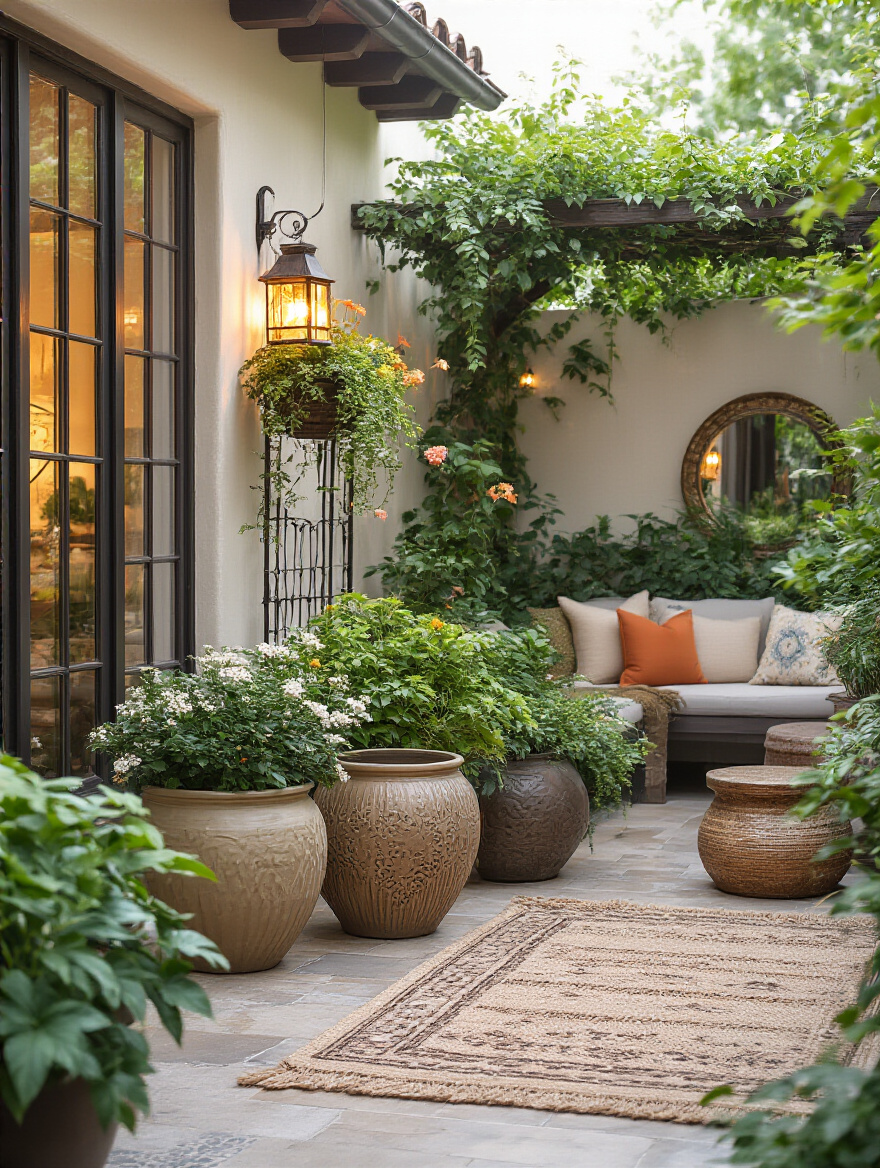
These details can also be highly functional. A decorative trellis can support a climbing plant while also screening an unsightly view. A beautiful ceramic stool can serve as a small side table or extra seating. Think about elements that bring you joy and serve a purpose. An outdoor mirror can make a small space feel larger, while cushions and throws in outdoor-friendly fabrics invite people to sit down and stay a while.
These personal touches are what make the space uniquely yours. They infuse your patio with your style and personality, creating a place that doesn’t just look good in a photo but feels wonderful to actually be in.
Essential Maintenance for Long-Term Patio Plant Health (Part 1)
A beautiful patio garden is a living, evolving thing. It’s not a one-and-done project. But maintenance doesn’t have to be a chore. With a few smart, consistent habits, you can keep your plants healthy and thriving for the long haul. This is about nurturing the space you’ve created.
17. Implement Smart Watering Practices to Avoid Over or Under-Hydration
Watering is the most frequent conversation you’ll have with your plants. The trick is to learn how to listen. Instead of watering on a rigid schedule, check the soil first. The “finger test” is the most reliable tool you have: stick your finger one to two inches into the soil. If it feels dry, it’s time to water. If it feels moist, wait. It’s that simple. This single habit prevents both overwatering (the leading cause of death) and underwatering.
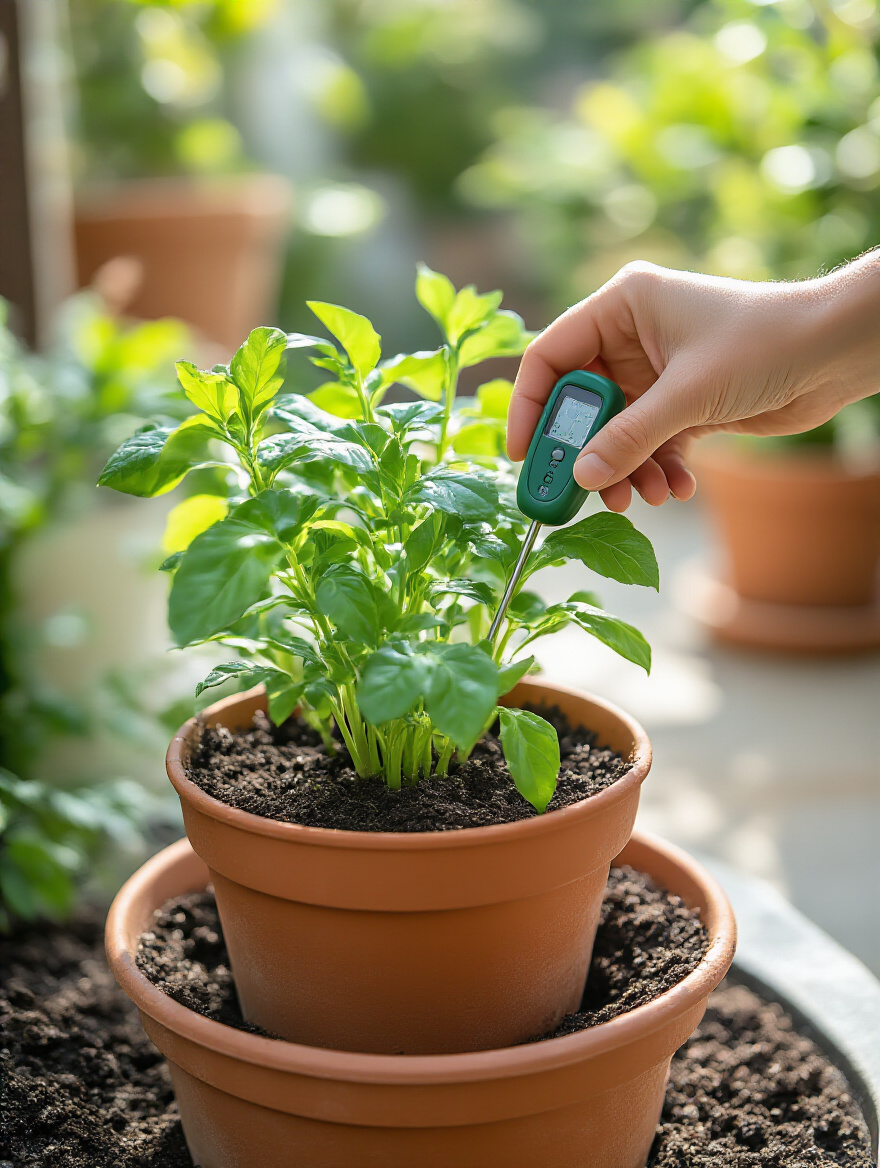
When you do water, do it deeply and thoroughly. Water until you see it running freely from the drainage holes at the bottom of the pot. This ensures the entire root ball gets a good drink, not just the top surface. Shallow, frequent sips encourage weak, shallow roots. A deep, less frequent soak encourages a strong, resilient root system.
Mastering this rhythm of checking and then watering deeply is the key to happy plants. It ensures they get exactly what they need, exactly when they need it, building a foundation of trust between you and your garden.
18. Develop a Consistent Feeding Schedule for Nutrient-Rich Growth
Think of a container pot as a tiny, isolated island. The plants inside have access only to the nutrients you provide in their potting mix, and they use them up quickly. Unlike plants in the ground, they can’t send their roots out searching for more. This is why a consistent feeding schedule is essential for their long-term health, especially for heavy-blooming annuals and vegetables.
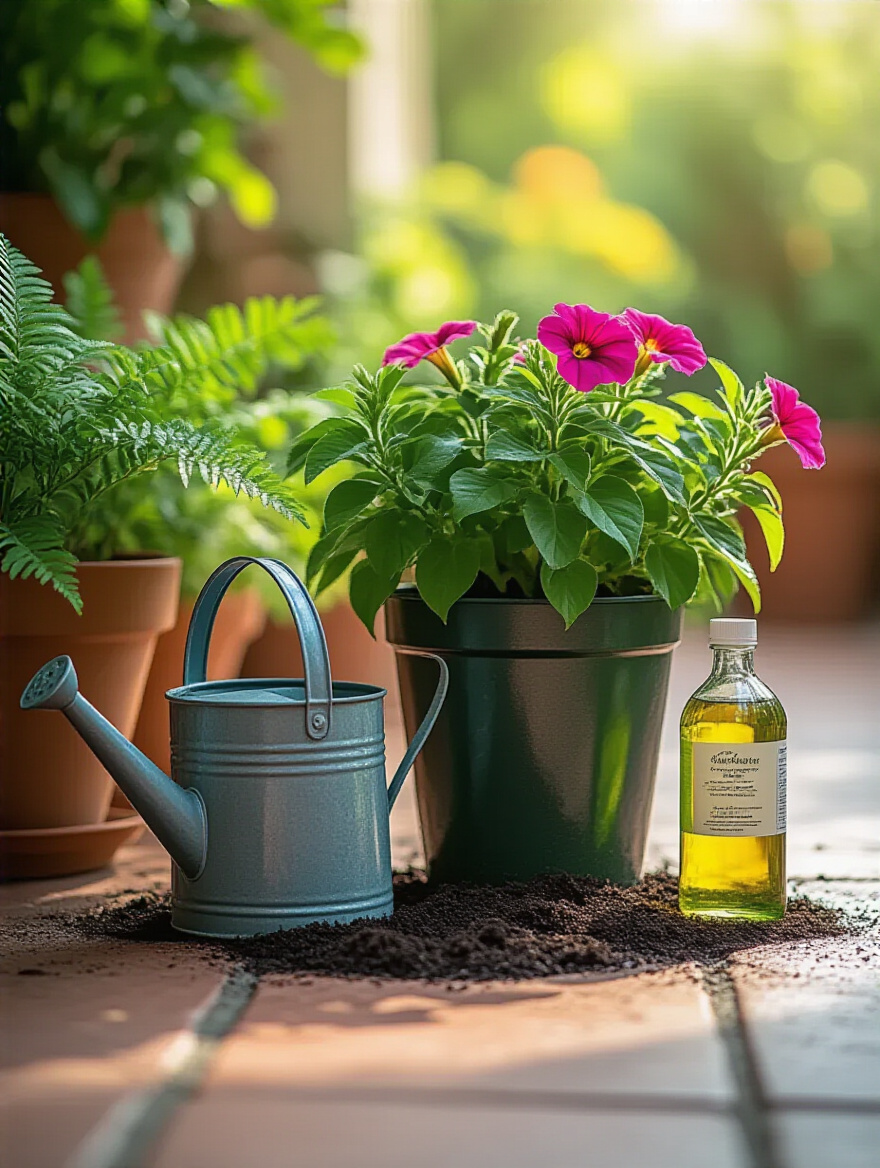
You don’t need a complicated chemical cocktail. A simple, balanced liquid fertilizer, diluted to half-strength and applied every couple of weeks during the growing season, is perfect for most plants. I like to think of it as giving them a regular, nourishing meal. Slow-release granular fertilizers are another fantastic, low-maintenance option—you just sprinkle them on the soil at the beginning of the season, and they feed your plants for months.
Consistent feeding is what fuels those gorgeous blooms and lush leaves all season long. It’s a simple act of replenishment that keeps your plant island supplied with everything it needs to thrive.
19. Monitor for Pests and Diseases with Early Detection Strategies
The best way to deal with pests and diseases is to spot them before they become a real problem. Make a habit of taking a slow, observant walk around your patio every few days. Look closely. Check the undersides of leaves, where pests love to hide. Look for any signs of trouble: spots, sticky residue, or tiny webs.
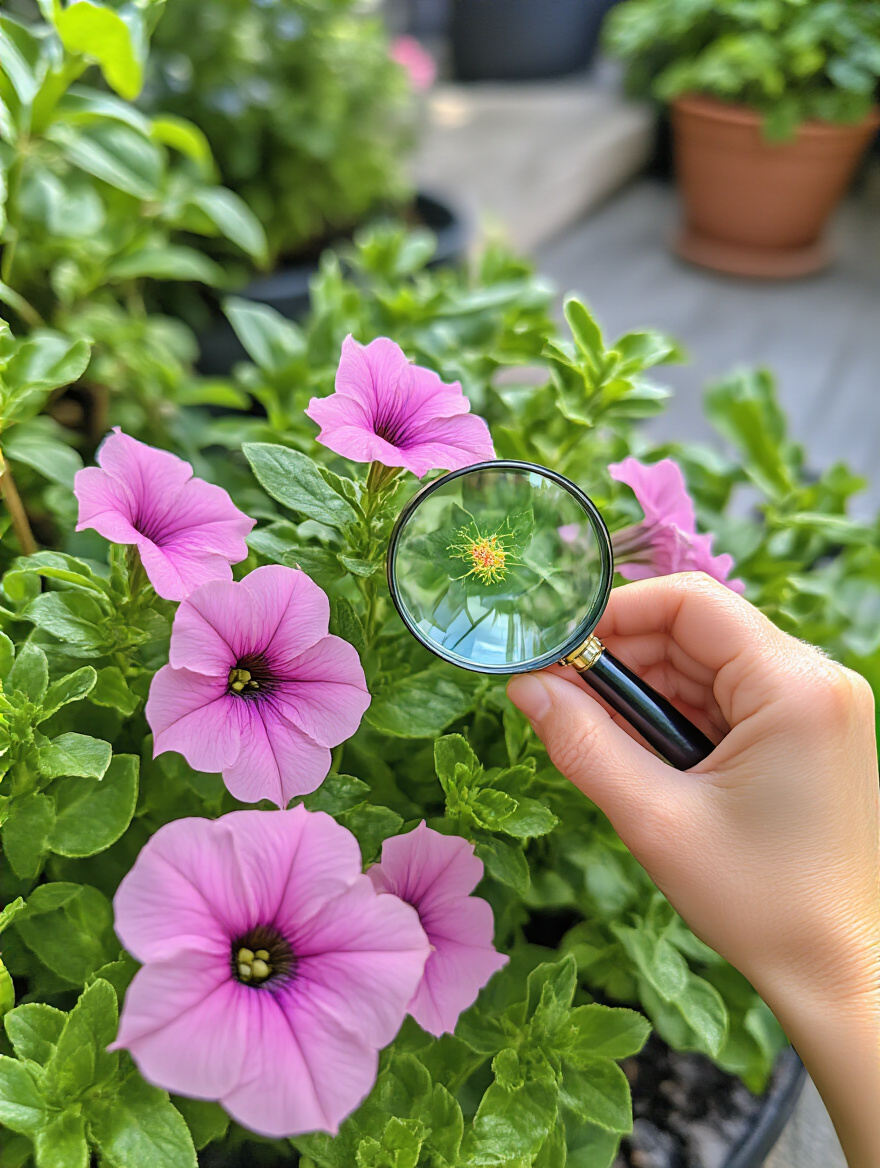
Early detection is your superpower. Spotting a few aphids on a new leaf means you can simply wipe them off with your fingers or a strong spray of water from the hose. Waiting until the entire plant is infested means you’ll be fighting a much bigger battle. Many “infestations” can be solved without any chemicals at all if they are caught in the first few days.
This practice of quiet observation not only protects your plants but also deepens your connection to them. You learn their normal rhythms and can spot when something is even slightly off, allowing you to be a gentle guardian rather than a chemical warrior.
20. Provide Seasonal Protection to Extend Plant Life Through Changing Weather
Our patios are not static environments. They face the full force of changing seasons, from summer heatwaves to winter frosts. For container plants, which don’t have the insulating protection of the earth around their roots, these extremes can be deadly. A little bit of proactive seasonal care can make all the difference.
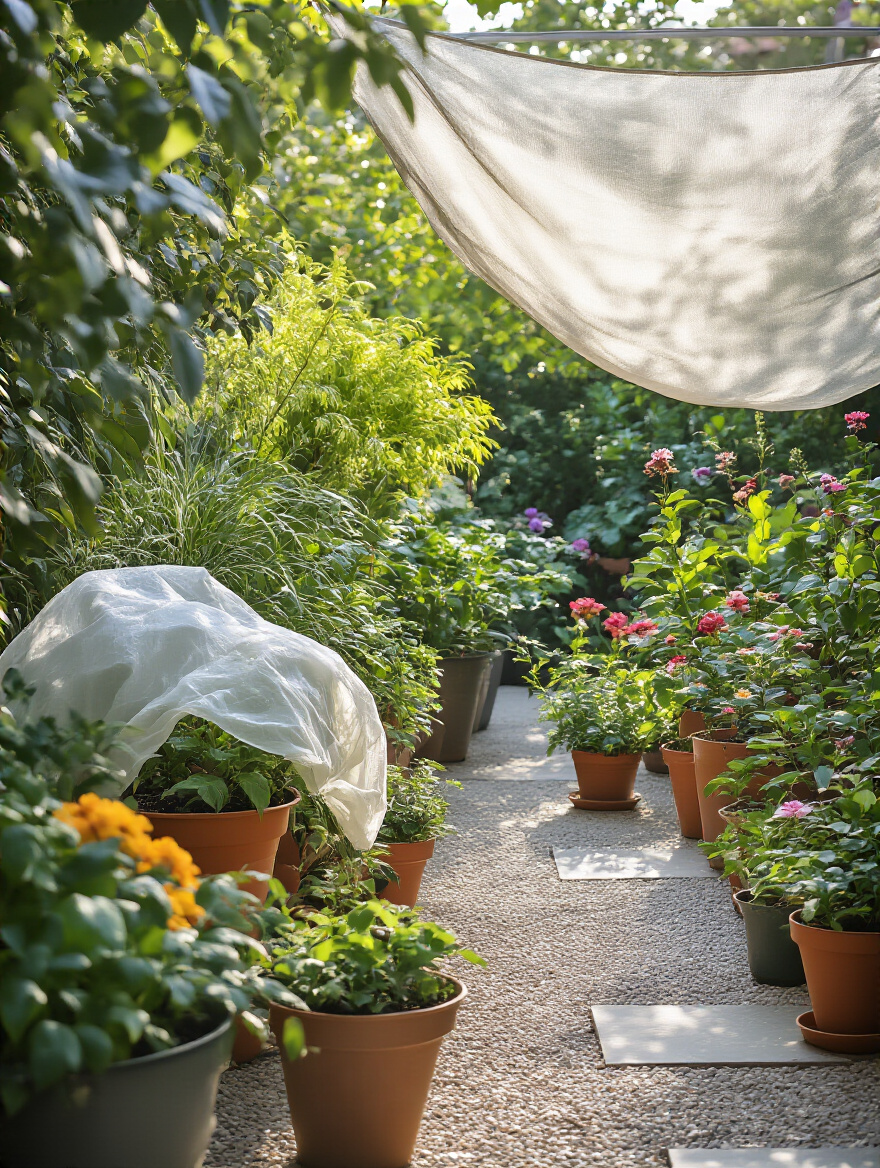
In the summer, a layer of mulch on top of the soil can help keep roots cool and conserve moisture. If a heatwave is forecast, you might need to move more sensitive plants to a shadier spot temporarily. For winter, know which of your plants are tender. These can be moved into a sheltered garage or even indoors. For borderline-hardy plants, grouping them together against a warm wall and covering them with a frost cloth during the coldest nights can be enough to see them through to spring. Using wheeled plant caddies for your heaviest pots makes this seasonal shuffle effortless.
Thinking ahead about seasonal challenges is a core part of creating a garden that endures. It’s an act of care that protects your investment of time and love, ensuring your favorite plants will be there to greet you again next year.
Essential Maintenance for Long-Term Patio Plant Health (Part 2)
As your garden grows and matures alongside you, its needs will change. These final practices are about the long-term relationship you have with your established plants, ensuring they stay healthy and beautiful for years to come.
21. Revitalize Established Plants Through Timely Pruning and Repotting
Eventually, even the happiest plant will outgrow its home. When you notice a plant seems to be drying out instantly after watering, or if its growth has slowed down, it might be time to repot. This doesn’t always mean moving to a gigantic new pot; sometimes it just means giving it a refresh. Slide the plant out and take a look. If the roots are a dense, tangled mass, it’s time for action.
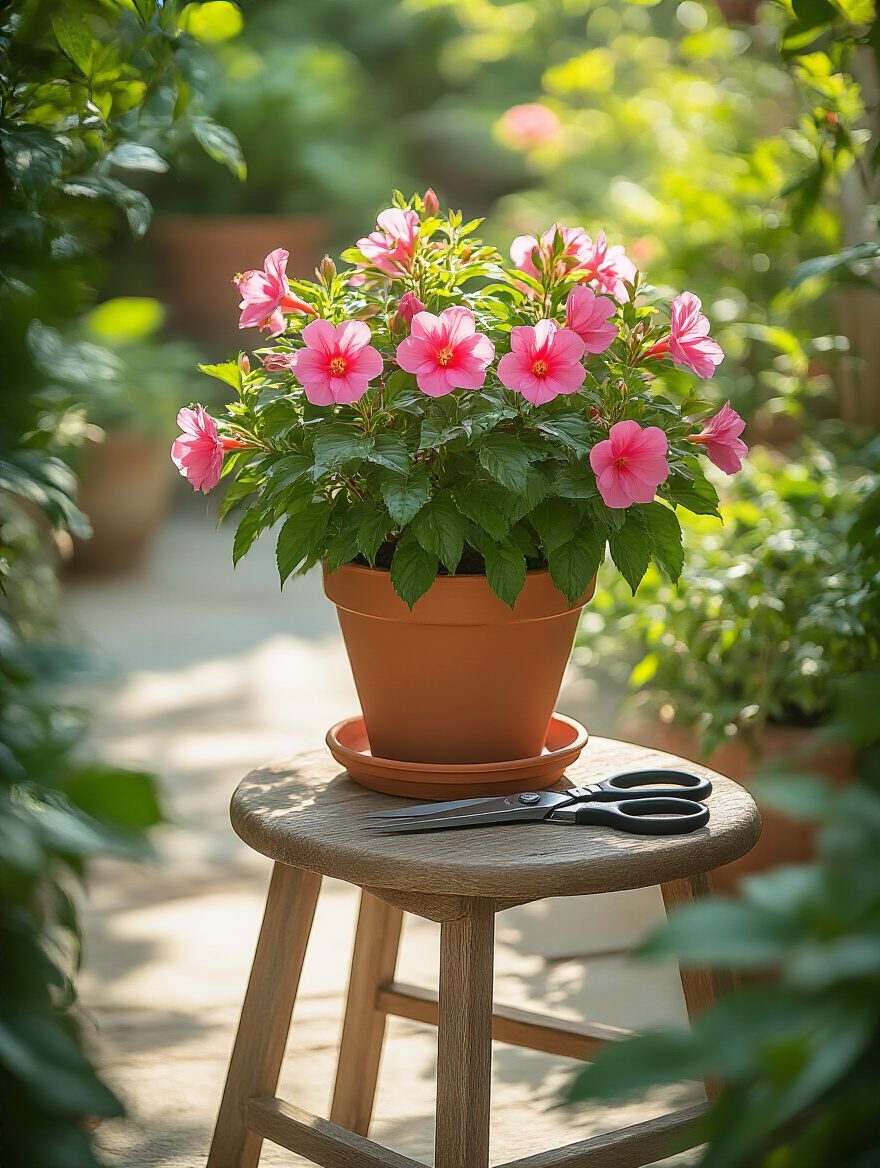
You can prune the roots just like you prune branches. Trim off about an inch from the outside of the root ball all the way around, then repot it back into the same container with fresh potting mix. This stimulates new, healthy root growth. At the same time, give the top of the plant a good prune, trimming back any leggy, overgrown, or dead stems. This redirects the plant’s energy into producing lush, new growth. It’s like a spa day for your plants, leaving them refreshed and revitalized.
This periodic renewal is the secret to keeping your patio plants healthy and vigorous for many, many years. It’s a bit of effort that pays off a hundred times over, allowing your garden to evolve and mature gracefully right alongside you.
Conclusion
Creating a thriving patio is not about achieving perfection. It’s about creating a personal, life-giving space that works for you, right now. It’s an act of care for yourself as much as for your plants. We’ve covered everything from the foundational planning to the joyful, finishing touches, but the most important thing is to simply begin. Don’t feel like you have to do all 21 things at once. Pick one. Buy one perfect pot, map your sunlight, or cluster a few plants you already have.
The goal is to create a living, breathing extension of your home—a place that anticipates your needs and brings you peace. Whether it’s a small balcony or a sprawling deck, these principles of thoughtful, inclusive design can help you cultivate a space that offers beauty and joy for every season of your life. Your own little paradise is waiting. Go on and bring it to life.
